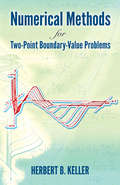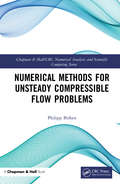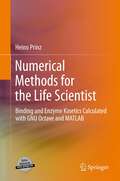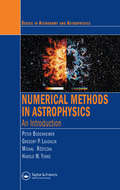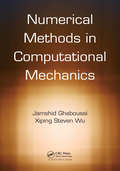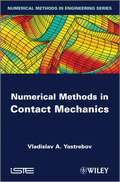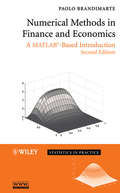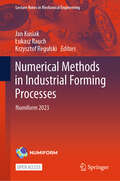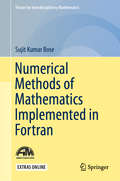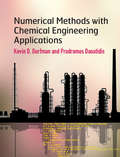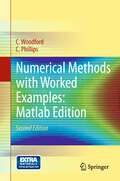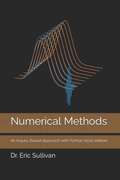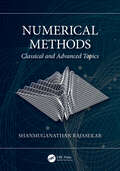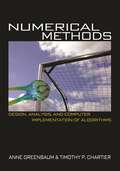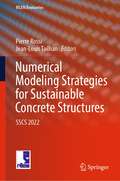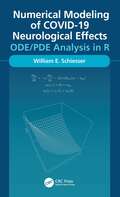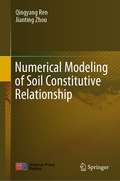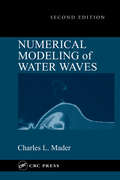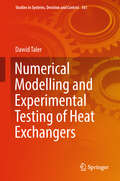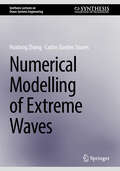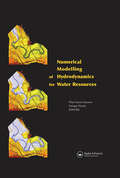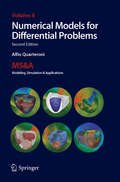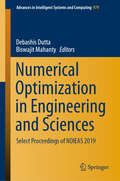- Table View
- List View
Numerical Methods for Two-Point Boundary-Value Problems (Dover Books on Mathematics)
by Herbert B. KellerA concise, elementary yet rigorous account of practical numerical methods for solving very general two-point boundary-value problems. Directed to students with a knowledge of advanced calculus and basic numerical analysis, and some background in ordinary differential equations and linear algebra. More than 100 problems augment and clarify the textual material. 1968 edition.
Numerical Methods for Unsteady Compressible Flow Problems (Chapman & Hall/CRC Numerical Analysis and Scientific Computing Series)
by Philipp BirkenNumerical Methods for Unsteady Compressible Flow Problems is written to give both mathematicians and engineers an overview of the state of the art in the field, as well as of new developments. The focus is on methods for the compressible Navier-Stokes equations, the solutions of which can exhibit shocks, boundary layers and turbulence. The idea of the text is to explain the important ideas to the reader, while giving enough detail and pointers to literature to facilitate implementation of methods and application of concepts. The book covers high order methods in space, such as Discontinuous Galerkin methods, and high order methods in time, in particular implicit ones. A large part of the text is reserved to discuss iterative methods for the arising large nonlinear and linear equation systems. Ample space is given to both state-of-the-art multigrid and preconditioned Newton-Krylov schemes. Features Applications to aerospace, high-speed vehicles, heat transfer, and more besides Suitable as a textbook for graduate-level courses in CFD, or as a reference for practitioners in the field
Numerical Methods for the Life Scientist
by Heino PrinzEnzyme kinetics, binding kinetics and pharmacological dose-response curves are currently analyzed by a few standard methods. Some of these, like Michaelis-Menten enzyme kinetics, use plausible approximations, others, like Hill equations for dose-response curves, are outdated. Calculating realistic reaction schemes requires numerical mathematical routines which usually are not covered in the curricula of life science. This textbook will give a step-by-step introduction to numerical solutions of non-linear and differential equations. It will be accompanied with a set of programs to calculate any reaction scheme on any personal computer. Typical examples from analytical biochemistry and pharmacology can be used as versatile templates. When a reaction scheme is applied for data fitting, the resulting parameters may not be unique. Correlation of parameters will be discussed and simplification strategies will be offered.
Numerical Methods in Astrophysics: An Introduction (Series in Astronomy and Astrophysics)
by Peter Bodenheimer Tomasz Plewa Gregory P. Laughlin Michal Rozyczka Harold. W YorkeNumerical Methods in Astrophysics: An Introduction outlines various fundamental numerical methods that can solve gravitational dynamics, hydrodynamics, and radiation transport equations. This resource indicates which methods are most suitable for particular problems, demonstrates what the accuracy requirements are in numerical simulations, a
Numerical Methods in Computational Mechanics
by Jamshid Ghaboussi Xiping Steven WuThis book explores the numerical algorithms underpinning modern finite element based computational mechanics software. It covers all the major numerical methods that are used in computational mechanics. It reviews the basic concepts in linear algebra and advanced matrix theory, before covering solution of systems of equations, symmetric eigenvalue solution methods, and direct integration of discrete dynamic equations of motion, illustrated with numerical examples. This book suits a graduate course in mechanics based disciplines, and will help software developers in computational mechanics. Increased understanding of the underlying numerical methods will also help practicing engineers to use the computational mechanics software more effectively.
Numerical Methods in Contact Mechanics (Wiley-iste Ser.)
by Vladislav A. YastrebovComputational contact mechanics is a broad topic which brings together algorithmic, geometrical, optimization and numerical aspects for a robust, fast and accurate treatment of contact problems. This book covers all the basic ingredients of contact and computational contact mechanics: from efficient contact detection algorithms and classical optimization methods to new developments in contact kinematics and resolution schemes for both sequential and parallel computer architectures. The book is self-contained and intended for people working on the implementation and improvement of contact algorithms in a finite element software. Using a new tensor algebra, the authors introduce some original notions in contact kinematics and extend the classical formulation of contact elements. Some classical and new resolution methods for contact problems and associated ready-to-implement expressions are provided. Contents: 1. Introduction to Computational Contact. 2. Geometry in Contact Mechanics. 3. Contact Detection. 4. Formulation of Contact Problems. 5. Numerical Procedures. 6. Numerical Examples. About the Authors Vladislav A. Yastrebov is a postdoctoral-fellow in Computational Solid Mechanics at MINES ParisTech in France. His work in computational contact mechanics was recognized by the CSMA award and by the Prix Paul Caseau of the French Academy of Technology and Electricité de France.
Numerical Methods in Engineering with MATLAB® Third Edition
by Jaan KiusalaasThe third edition of this successful text describes and evaluates a range of widely used numerical methods, with an emphasis on problem solving. Every method is discussed thoroughly and illustrated with problems involving both hand computation and programming. MATLAB® M-files accompany each method and are available on the book's web page. Code is made simple and easy to understand by avoiding complex book-keeping schemes, while maintaining the essential features of the method. The third edition features a new chapter on Euler's method, a number of new and improved examples and exercises, and programs which appear as function M-files. Numerical Methods in Engineering with MATLAB®, 3rd edition is a useful resource for both graduate students and practicing engineers.
Numerical Methods in Finance and Economics
by Paolo BrandimarteA state-of-the-art introduction to the powerful mathematical and statistical tools used in the field of financeThe use of mathematical models and numerical techniques is a practice employed by a growing number of applied mathematicians working on applications in finance. Reflecting this development, Numerical Methods in Finance and Economics: A MATLAB?-Based Introduction, Second Edition bridges the gap between financial theory and computational practice while showing readers how to utilize MATLAB?--the powerful numerical computing environment--for financial applications.The author provides an essential foundation in finance and numerical analysis in addition to background material for students from both engineering and economics perspectives. A wide range of topics is covered, including standard numerical analysis methods, Monte Carlo methods to simulate systems affected by significant uncertainty, and optimization methods to find an optimal set of decisions.Among this book's most outstanding features is the integration of MATLAB?, which helps students and practitioners solve relevant problems in finance, such as portfolio management and derivatives pricing. This tutorial is useful in connecting theory with practice in the application of classical numerical methods and advanced methods, while illustrating underlying algorithmic concepts in concrete terms.Newly featured in the Second Edition:* In-depth treatment of Monte Carlo methods with due attention paid to variance reduction strategies* New appendix on AMPL in order to better illustrate the optimization models in Chapters 11 and 12* New chapter on binomial and trinomial lattices* Additional treatment of partial differential equations with two space dimensions* Expanded treatment within the chapter on financial theory to provide a more thorough background for engineers not familiar with finance* New coverage of advanced optimization methods and applications later in the textNumerical Methods in Finance and Economics: A MATLAB?-Based Introduction, Second Edition presents basic treatments and more specialized literature, and it also uses algebraic languages, such as AMPL, to connect the pencil-and-paper statement of an optimization model with its solution by a software library. Offering computational practice in both financial engineering and economics fields, this book equips practitioners with the necessary techniques to measure and manage risk.
Numerical Methods in Industrial Forming Processes: Numiform 2023 (Lecture Notes in Mechanical Engineering)
by Jan Kusiak Łukasz Rauch Krzysztof RegulskiThis open access book comprises selected papers presented at the NUMIFORM 2023 conference, where recent developments, innovations and advances in numerical methods for material forming and shaping through plastic deformation were discussed. The conference topics include the broad areas of material behaviour and modelling and its numerical implementation; process modelling (forming, joining, machining, casting, welding/joining and additive manufacturing, etc., of metals, polymers and composites) and its numerical implementation; and conventional and novel methods of forming and joining metals and polymer and composite processing. This book serves as a valuable reference for academicians and industry professionals alike.
Numerical Methods of Mathematics Implemented in Fortran (Forum for Interdisciplinary Mathematics)
by Sujit Kumar BoseThis book systematically classifies the mathematical formalisms of computational models that are required for solving problems in mathematics, engineering and various other disciplines. It also provides numerical methods for solving these problems using suitable algorithms and for writing computer codes to find solutions. For discrete models, matrix algebra comes into play, while for continuum framework models, real and complex analysis is more suitable. The book clearly describes the method–algorithm–code approach for learning the techniques of scientific computation and how to arrive at accurate solutions by applying the procedures presented. It not only provides instructors with course material but also serves as a useful reference resource. Providing the detailed mathematical proofs behind the computational methods, this book appeals to undergraduate and graduate mathematics and engineering students.The computer codes have been written in the Fortran programming language, which is the traditional language for scientific computation. Fortran has a vast repository of source codes used in real-world applications and has continuously been upgraded in line with the computing capacity of the hardware. The language is fully backwards compatible with its earlier versions, facilitating integration with older source codes.
Numerical Methods with Chemical Engineering Applications
by Prodromos Daoutidis Kevin D. DorfmanDesigned primarily for undergraduates, but also graduates and practitioners, this textbook integrates numerical methods and programming with applications from chemical engineering. Combining mathematical rigor with an informal writing style, it thoroughly introduces the theory underlying numerical methods, its translation into MATLAB programs, and its use for solving realistic problems. Specific topics covered include accuracy, convergence and numerical stability, as well as stiffness and ill-conditioning. MATLAB codes are developed from scratch, and their implementation is explained in detail, all while assuming limited programming knowledge. All scripts employed are downloadable, and built-in MATLAB functions are discussed and contextualised. Numerous examples and homework problems - from simple questions to extended case studies - accompany the text, allowing students to develop a deep appreciation for the range of real chemical engineering problems that can be solved using numerical methods. This is the ideal resource for a single-semester course on numerical methods, as well as other chemical engineering courses taught over multiple semesters.
Numerical Methods with Worked Examples: Matlab Edition
by C. Phillips C. WoodfordThis book is for students following an introductory course in numerical methods, numerical techniques or numerical analysis. It introduces MATLAB as a computing environment for experimenting with numerical methods. It approaches the subject from a pragmatic viewpoint; theory is kept at a minimum commensurate with comprehensive coverage of the subject and it contains abundant worked examples which provide easy understanding through a clear and concise theoretical treatment. This edition places even greater emphasis on 'learning by doing' than the previous edition. Fully documented MATLAB code for the numerical methods described in the book will be available as supplementary material to the book on http://extras.springer.com
Numerical Methods: An Inquiry Based Approach With Python
by Eric SullivanThis book is an inquiry-based approach to a first semester undergraduate Numerical Methods or Numerical Analysis course. The book covers floating point arithmetic, function approximation via Taylor series, numerical root finding, numerical differentiation and integration, an introduction to computational optimization, several methods from numerical linear algebra, several methods from ordinary differential equations, and an introduction to numerical partial differential equations. As an inquiry-based book this is a not a traditional text with complete exposition. Instead, this book contains collections of exercises that guide the student through the building and analysis of numerical algorithms. A heavy emphasis is put on numerical experimentation instead of mathematical proof. Each chapter ends with collections of challenging exercises and projects. Students are encouraged to work every example and exercise in the book to gain full understanding of the material. The primary programming language for this book is Python with an emphasis on using numpy, matplotlib, and scipy to solve computational problems. The intended student audience is sophomore to junior level STEM majors with a background in Calculus, Linear Algebra, and Differential equations.
Numerical Methods: Classical and Advanced Topics
by Shanmuganathan RajasekarThis book presents a pedagogical treatment of a wide range of numerical methods to suit the needs of undergraduate and postgraduate students, and teachers and researchers in physics, mathematics, and engineering. For each method, the derivation of the formula/algorithm, error analysis, case studies, applications in science and engineering and the special features are covered. A detailed presentation of solving time-dependent Schrödinger equation and nonlinear wave equations, along with the Monte Carlo techniques (to mention a few) will aid in students’ understanding of several physical phenomena including tunnelling, elastic collision of nonlinear waves, electronic distribution in atoms, and diffusion of neutrons through simulation study.The book covers advanced topics such as symplectic integrators and random number generators for desired distributions and Monte Carlo techniques, which are usually overlooked in other numerical methods textbooks. Interesting updates on classical topics include: curve fitting to a sigmoid and Gaussian functions and product of certain two functions, solving of differential equations in the presence of noise, and solving the time-independent Schrödinger equation.Solutions are presented in the forms of tables and graphs to provide visual aid and encourage a deeper comprehension of the topic. The step-by-step computations presented for most of the problems can be verifiable using a scientific calculator and is therefore appropriate for classroom teaching. The readers of the book will benefit from acquiring an acquittance, knowledge, experience and realization of significance of the numerical methods covered, their applicability to physical and engineering problems and the advantages of applying numerical methods over theoretical methods for specific problems.
Numerical Methods: Design, Analysis, and Computer Implementation of Algorithms
by Anne Greenbaum Tim P. ChartierA rigorous and comprehensive introduction to numerical analysisNumerical Methods provides a clear and concise exploration of standard numerical analysis topics, as well as nontraditional ones, including mathematical modeling, Monte Carlo methods, Markov chains, and fractals. Filled with appealing examples that will motivate students, the textbook considers modern application areas, such as information retrieval and animation, and classical topics from physics and engineering. Exercises use MATLAB and promote understanding of computational results.The book gives instructors the flexibility to emphasize different aspects—design, analysis, or computer implementation—of numerical algorithms, depending on the background and interests of students. Designed for upper-division undergraduates in mathematics or computer science classes, the textbook assumes that students have prior knowledge of linear algebra and calculus, although these topics are reviewed in the text. Short discussions of the history of numerical methods are interspersed throughout the chapters. The book also includes polynomial interpolation at Chebyshev points, use of the MATLAB package Chebfun, and a section on the fast Fourier transform. Supplementary materials are available online.Clear and concise exposition of standard numerical analysis topicsExplores nontraditional topics, such as mathematical modeling and Monte Carlo methodsCovers modern applications, including information retrieval and animation, and classical applications from physics and engineeringPromotes understanding of computational results through MATLAB exercisesProvides flexibility so instructors can emphasize mathematical or applied/computational aspects of numerical methods or a combinationIncludes recent results on polynomial interpolation at Chebyshev points and use of the MATLAB package ChebfunShort discussions of the history of numerical methods interspersed throughoutSupplementary materials available online
Numerical Modeling Strategies for Sustainable Concrete Structures: SSCS 2022 (RILEM Bookseries #38)
by Pierre Rossi Jean-Louis TailhanThis volume highlights the latest advances, innovations, and applications in the field of sustainable concrete structures, as presented by scientists and engineers at the RILEM International Conference on Numerical Modeling Strategies for Sustainable Concrete Structures (SSCS), held in Marseille, France, on July 4-6, 2022. It demonstrates that numerical methods (finite elements, finite volumes, finite differences) are a relevant response to the challenge to optimize the utilization of cement in concrete constructions while checking that these constructions have a lifespan compatible with the stakes of sustainable development. They are indeed accurate tools for an optimized design of concrete constructions, and allow us to consider all types of complexities: for example, those linked to rheological, physicochemical and mechanical properties of concrete, those linked to the geometry of the structures or even to the environmental boundary conditions. This optimization must also respect constraints of time, money, security, energy, CO2 emissions, and, more generally, life cycle more reliably than the codes and analytical approaches currently used. Numerical methods are, undoubtedly, the best calculation tools at the service of concrete eco-construction. The contributions present traditional and new ideas that will open novel research directions and foster multidisciplinary collaboration between different specialists.
Numerical Modeling of COVID-19 Neurological Effects: ODE/PDE Analysis in R
by William SchiesserCovid-19 is primarily a respiratory disease which results in impaired oxygenation of blood. The O2-deficient blood then moves through the body, and for the study in this book, the focus is on the blood flowing to the brain. The dynamics of blood flow along the brain capillaries and tissue is modeled as systems of ordinary and partial differential equations (ODE/PDEs). The ODE/PDE methodology is presented through a series of examples, 1. A basic one PDE model for O2 concentration in the brain capillary blood. 2. A two PDE model for O2 concentration in the brain capillary blood and in the brain tissue, with O2 transport across the blood brain barrier (BBB). 3. The two model extended to three PDEs to include the brain functional neuron cell density. Cognitive impairment could result from reduced neuron cell density in time and space (in the brain) that follows from lowered O2 concentration (hypoxia). The computer-based implementation of the example models is presented through routines coded (programmed) in R, a quality, open-source scientific computing system that is readily available from the Internet. Formal mathematics is minimized, e.g., no theorems and proofs. Rather, the presentation is through detailed examples that the reader/researcher/analyst can execute on modest computers. The PDE analysis is based on the method of lines (MOL), an established general algorithm for PDEs, implemented with finite differences. The routines are available from a download link so that the example models can be executed without having to first study numerical methods and computer coding. The routines can then be applied to variations and extensions of the blood/brain hypoxia models, such as changes in the ODE/PDE parameters (constants) and form of the model equations.
Numerical Modeling of Soil Constitutive Relationship
by Qingyang Ren Jianting ZhouThis book adopts numerical method to model soil constitutive relationship while it abandons the traditional idea of looking for plastic potential as the only way to model. Firstly, the triaxial compression tests of expansive soil, sand and clay under different stress paths are introduced; then the elastoplastic constitutive equations of expansive soil, sand and clay under various stress paths are established by numerical modeling method; finally, the constitutive equations are embedded in the finite element program and verified by comparing the finite element calculation results of the triaxial test soil samples with the corresponding test results. The modeling obtains high accuracy.
Numerical Modeling of Water Waves
by Charles L. MaderNumerical Modeling of Water Waves, Second Edition covers all aspects of this subject, from the basic fluid dynamics and the simplest models to the latest and most complex, including the first-ever description of techniques for modeling wave generation by explosions, projectile impacts, asteroids, and impact landslides. The book comes packaged with
Numerical Modelling and Experimental Testing of Heat Exchangers (Studies in Systems, Decision and Control #161)
by Dawid TalerThis book presents new methods of numerical modelling of tube heat exchangers, which can be used to perform design and operation calculations of exchangers characterized by a complex flow system. It also proposes new heat transfer correlations for laminar, transition and turbulent flows. A large part of the book is devoted to experimental testing of heat exchangers, and methods for assessing the indirect measurement uncertainty are presented. Further, it describes a new method for parallel determination of the Nusselt number correlations on both sides of the tube walls based on the nonlinear least squares method and presents the application of computational fluid dynamic (CFD) modeling to determine the air-side Nusselt number correlations. Lastly, it develops a control system based on the mathematical model of the car radiator and compares this with the digital proportional-integral-derivative (PID) controller. The book is intended for students, academics and researchers, as well as for designers and manufacturers of heat exchangers.
Numerical Modelling of Extreme Waves (Synthesis Lectures on Ocean Systems Engineering)
by Huidong Zhang Carlos Guedes SoaresThis book describes some approaches for developing the numerical models to efficiently predict the formation of extreme waves which can pose a threat to the safety of marine structures. The numerical algorithms for solving different governing equations and the theoretical probability models for extreme wave predictions are explained in detail. These models can help engineers in the design of marine structures that can withstand extreme waves. With more frequent extreme weather due to climate change, extreme waves have become more common. Extreme waves are an interesting phenomenon, but because of their enormous destructive power, understanding their formation mechanism, properties, and impact, is necessary for the design and safe operation of ships and offshore structures.
Numerical Modelling of Hydrodynamics for Water Resources: Proceedings of the Conference on Numerical Modelling of Hydrodynamic Systems (Zaragoza, Spain, 18-21 June 2007)
by Pilar García-Navarro Enrique PlayánThe presentations collected in this volume have a problem-oriented perspective, and focus on canal and river flow, riparian areas and aquifers. 'Numerical Modelling of Hydrodynamics for Water Resources' is highly relevant to those working in hydrology, civil engineering, and environmental and agricultural sectors.
Numerical Models for Differential Problems
by Alfio QuarteroniIn this text, we introduce the basic concepts for the numerical modelling of partial differential equations. We consider the classical elliptic, parabolic and hyperbolic linear equations, but also the diffusion, transport, and Navier-Stokes equations, as well as equations representing conservation laws, saddle-point problems and optimal control problems. Furthermore, we provide numerous physical examples which underline such equations. We then analyze numerical solution methods based on finite elements, finite differences, finite volumes, spectral methods and domain decomposition methods, and reduced basis methods. In particular, we discuss the algorithmic and computer implementation aspects and provide a number of easy-to-use programs. The text does not require any previous advanced mathematical knowledge of partial differential equations: the absolutely essential concepts are reported in a preliminary chapter. It is therefore suitable for students of bachelor and master courses in scientific disciplines, and recommendable to those researchers in the academic and extra-academic domain who want to approach this interesting branch of applied mathematics.
Numerical Notation
by Stephen ChrisomalisThis book is a cross-cultural reference volume of all attested numerical notation systems (graphic, non-phonetic systems for representing numbers), encompassing more than 100 such systems used over the past 5,500 years. Using a typology that defies progressive, unilinear evolutionary models of change, Stephen Chrisomalis identifies five basic types of numerical notation systems, using a cultural phylogenetic framework to show relationships between systems and to create a general theory of change in numerical systems. Numerical notation systems are primarily representational systems, not computational technologies. Cognitive factors that help explain how numerical systems change relate to general principles, such as conciseness or avoidance of ambiguity, which apply also to writing systems. The transformation and replacement of numerical notation systems relates to specific social, economic, and technological changes, such as the development of the printing press or the expansion of the global world-system.
Numerical Optimization in Engineering and Sciences: Select Proceedings of NOIEAS 2019 (Advances in Intelligent Systems and Computing #979)
by Debashis Dutta Biswajit MahantyThis book presents select peer-reviewed papers presented at the International Conference on Numerical Optimization in Engineering and Sciences (NOIEAS) 2019. The book covers a wide variety of numerical optimization techniques across all major engineering disciplines like mechanical, manufacturing, civil, electrical, chemical, computer, and electronics engineering. The major focus is on innovative ideas, current methods and latest results involving advanced optimization techniques. The contents provide a good balance between numerical models and analytical results obtained for different engineering problems and challenges. This book will be useful for students, researchers, and professionals interested in engineering optimization techniques.
